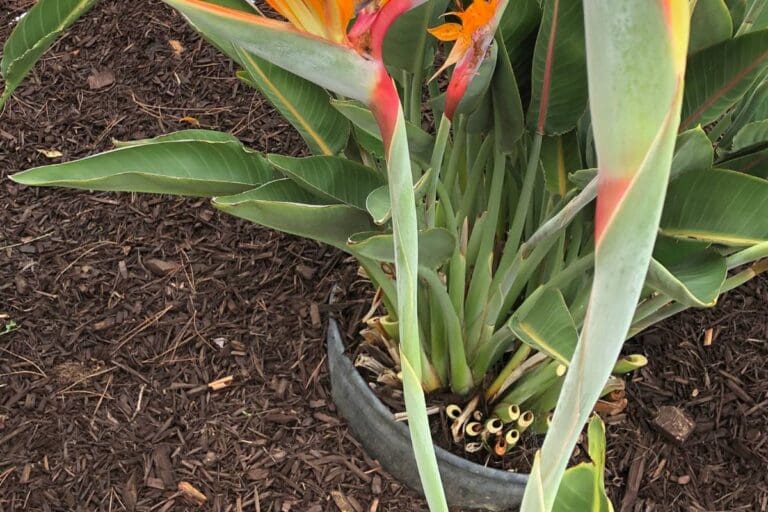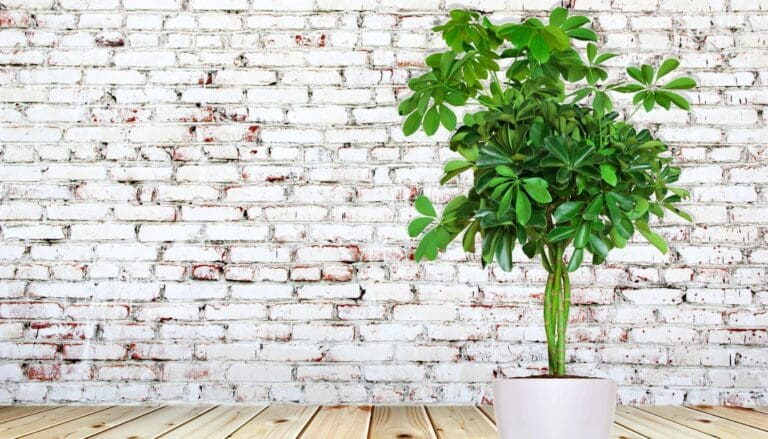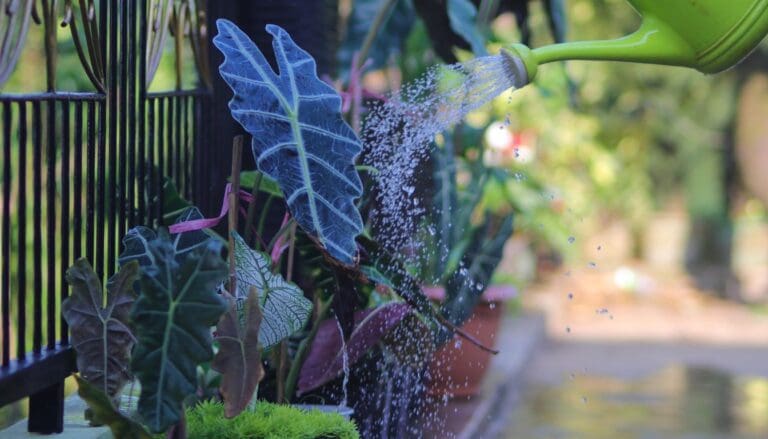Can I Mist My Rubber Plant? (Advantages+Disadvantages)
Rubber plants can thrive in various conditions if their requirements are met. One of the most essential requirements is moisture and humidity. While misting can maintain moisture and humidity, is it a good idea to mist your Rubber plants? Let’s see.
Misting the Rubber plants can help in several ways. It can increase the humidity levels by adding moisture to the air, keep the plant hydrated, and help clean the leaves. If increasing humidity is your primary goal, try other effective methods.
In this guide, we will explore all things related to misting, how misting can help the Rubber plants, delve deep into the humidity requirements of the Rubber plant, and learn practical ways to humidity.

Please note: Simplify Plants is reader-supported. Some links in the post are affiliate links and I get a commission from purchases made through links in the post.
Understanding Rubber Plant Humidity Preferences and misting requirements
Humidity requirements for most tropical houseplants are always high, and Rubber plants are no exception.
Rubber plants, or Ficus Elastica, belong to the tropical rainforests where they thrive under high humidity.
However, the indoor humidity levels are very different from their native land.
Besides, the Rubber tree plants do not need very high humidity as houseplants.
Rubber plants enjoy staying consistently moist.
Therefore, a stable humidity level for their growth and development is enough.
Lack of humidity reduces transpiration, further impacting their health negatively.
The ideal humidity level for Ficus Elastica is around 50% to 60%.
It is neither very high nor too low. An average household humidity is okay for them.
But will misting the Rubber plant help in adjusting the humidity levels? Let’s read.
Do Rubber plants like to be misted?
Rubber plants are native to the tropical rainforest areas.
The humidity requirement for these tropical plants is around 50% to 60%.
You can mist the Rubber plants.
Occasional misting will improve the humidity levels and keep the plant hydrated and healthy.
You can also mist your Rubber plant soil during the cold winters.
Since the plant goes dormant, it doesn’t require deep watering.
A bit of moistness for hydration is enough.
Misting comes in handy when the surrounding air is dry and the humidity is low. Periodic misting can maintain hydration.
But a good thing is that the Rubber plants do not require very high humidity.
Around 50-60% is enough for them. So, misting can be advantageous.
If you want to mist the houseplant only to improve the humidity levels, there are other effective methods than misting.
When and how often to mist your Rubber plants?

We all know that misting during dry weather can increase the humidity level around the Rubber plants.
While it is correct, it’s not suitable if the weather is arid.
When you mist during a dry environment, the water evaporates faster from the leaves.
In a dry environment, misting won’t help maintain humidity; opt for more effective methods instead.
Misting is beneficial for Rubber plants in colder regions with low humidity but not excessively dry weather.
Misting can keep the surroundings humid.
Additionally, Rubber plants don’t need deep watering in winter.
Misting the soil can keep them hydrated while avoiding overwatering.
Placement also matters when it comes to misting frequency.
Rubber plants do not prefer bright, direct sunlight.
If you have placed the plant near a sunny window, water can dry out faster. In that case, you have to mist more often.
But if you have kept the plant at places with high humidity levels, like near the kitchen, washroom, or basement, go easy with misting.
I consider misting the Rubber plant during the day.
By the end of the day, the green leaves dry out.
Even if they don’t dry out, I pat them dry with a cloth to avoid wet leaves.
It can invite pests and insects like powdery mildew.
Can I overmist the Rubber plants?
Too much of anything can be dangerous, as is the case here.
Repeated misting can gather too much moisture in the leaf surfaces.
If the leaves don’t dry out, it can invite fungus and pests to reach your plant and damage it.
While misting is a good thing, you should ensure no water pools on the leaf surfaces.
If the leaves remain wet, use a cloth to pat them dry.
This prevents fungi and pests and also cleans the leaves in the process.
Advantages and disadvantages of misting
Misting is controversial because some gardeners are for it while others are against it.
Some have received good results, while others did not find anything special.
Due to this, I keep getting questions from my readers whether or not to mist the Rubber plant or any houseplant.
From what I have experienced, misting has both advantages and disadvantages.
Let’s look at the merits and demerits of misting and see if we can find ways to adjust the demerits.

Advantages
- Misting can maintain the humidity level of your Rubber plant to some extent.
- Rubber plant leaves are big and get dirty quickly. It needs regular cleaning individually. With misting, you can clean the leaves while adjusting the humidity levels.
- Misting can also keep your foliage shiny and provide deeper variegation.
- With misting, you can keep the pests and fungus at bay. Add some neem oil to the water and mist the plant as you do it regularly. Follow this every 15 days.
Disadvantages
- If the humidity of your region is high, water droplets from misting will remain on the leaf surface and damage the leaves.
- Leaves staying wet for too long can invite pests and diseases, especially powdery mildew.
- If the dry in your region is too dry, misting doesn’t work. You have to try other methods to increase humidity and maintain moisture.
- Fortunately, there are ways to tackle the disadvantages.
- If your region’s humidity is already high, you don’t have to take any steps to increase the humidity. Skip misting.
- If you are misting, check the leaves by the end of the day and see if they have dried. If not, take extra time to pat dry the wet leaves with a cloth or paper towel. It won’t invite any infestations.
- In dry regions, try humidifiers, pebble trays, or grouping plants to adjust humidity levels effectively. Keep reading to learn about these methods in detail.
Rubber plant and low humidity
Misting is crucial for adjusting Rubber plants’ humidity levels, emphasizing the plant’s essential need for adequate humidity.
Low humidity levels can take away the moisture and hydration from the plant, reduce transpiration, and affect the plant’s health.
As a plant grower, you should prevent this and provide ideal humidity levels to keep your plant healthy and happening.
But how will you identify that the plant is receiving low humidity?
Here are some signs:
- Yellow leaves
- Dry and crispy leaves
- Leaf tips turning brown.
- Drooping and wilting of the leaves
These signs also indicate other issues like overwatering, underwatering, or over-fertilization. So, how will you understand this?
Here’s a solution.
First, find out that these three are not the issue.
Once you have ruled out, you can confirm that humidity is the culprit.
Another way to understand this is to measure the humidity level of the room using a hygrometer.
It is a device that provides you with the accurate humidity level of your room.
Why do you need this? The humidity levels depend on several factors, like weather and room temperature.
Besides, the humidity levels are different in different rooms.
For example, the humidity level of your bedroom, drawing room, and study room is much lower than your kitchen, bathroom, and basement.
Keep the hygrometer in the room where you want to keep the Rubber plant.
The accurate result will tell you whether the plant suffers from low humidity and how much adjustment is needed.
How to increase the humidity levels for the Rubber plants?
Once you have learned that humidity is the culprit behind a stressed Rubber plant, it is time to adjust it.
The humidity levels in the homes are quite different from the Rubber plant’s native land.
Therefore, you must adjust it and mimic the exact level as its native habitat.
Misting these houseplants is one way to adjust it.
Besides that, there are other effective methods:
Install Humidifiers for Rubber plants
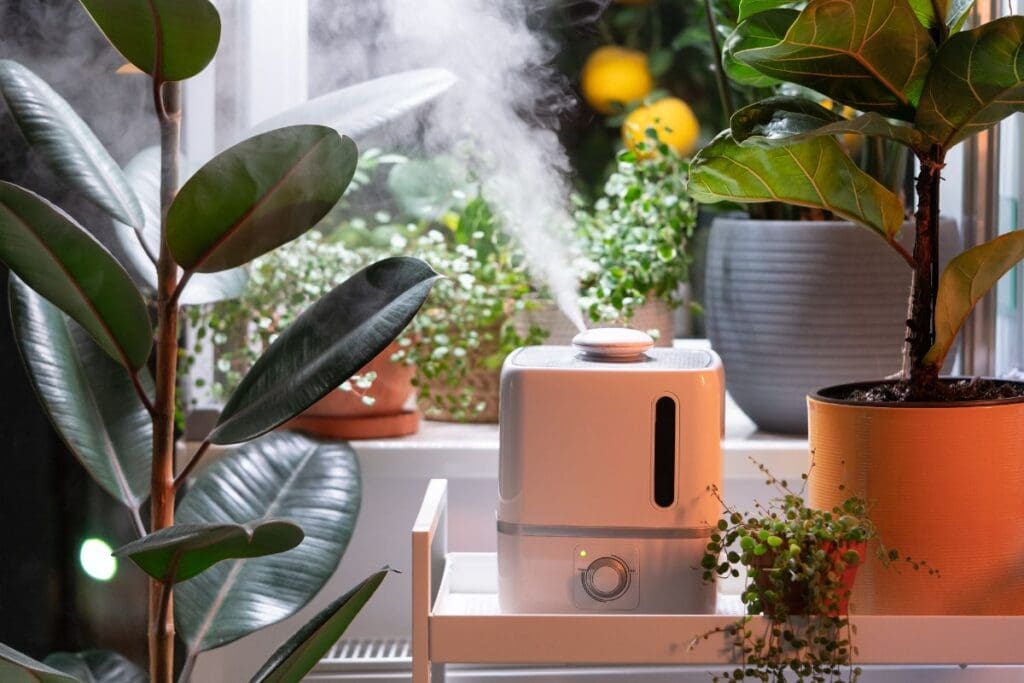
Installing humidifiers is one of the easiest and most effective methods to increase the humidity levels in homes.
Several gardeners have used it and found it to be an excellent way to increase the humidity of the entire room.
My Rubber plants have always thrived after I started using the humidifier.
If you don’t have time to look for a suitable humidifier, look at this humidifier (Levoit Humidifiers for Home Large Room Bedroom).
I have been using it for a long time, which significantly serves the purpose.
Whenever the humidity levels go lower than 40-50%, switch on the humidifier, and it will do the needful.
Pebble tray for humidity
Don’t want to invest money in a humidifier?
Try the pebble tray method.
Take a tray, fill it with pebbles and water, and put it under the Rubber plant pot.
As the water evaporates, it adds extra moisture around the Rubber plants.
You have to keep checking the tray for the water level.
Every time the water level goes down, add water.
Ensure the pot’s bottom doesn’t touch the water on the tray.
Keeping the Rubber plant close to the aquarium for humidity levels
Do you have an aquarium in your house? You don’t have to spend money on a humidifier or make a pebble tray.
Pick up your Rubber plant and place it near the aquarium.
As the water from the aquarium evaporates, it adds humidity to the air, and the plant will benefit from it.
Putting big water tanks near the plant also does the same job.
While changing the location, make sure that the plant can receive bright indirect light and stay away from cold drafts.
Grouping plants for humidity
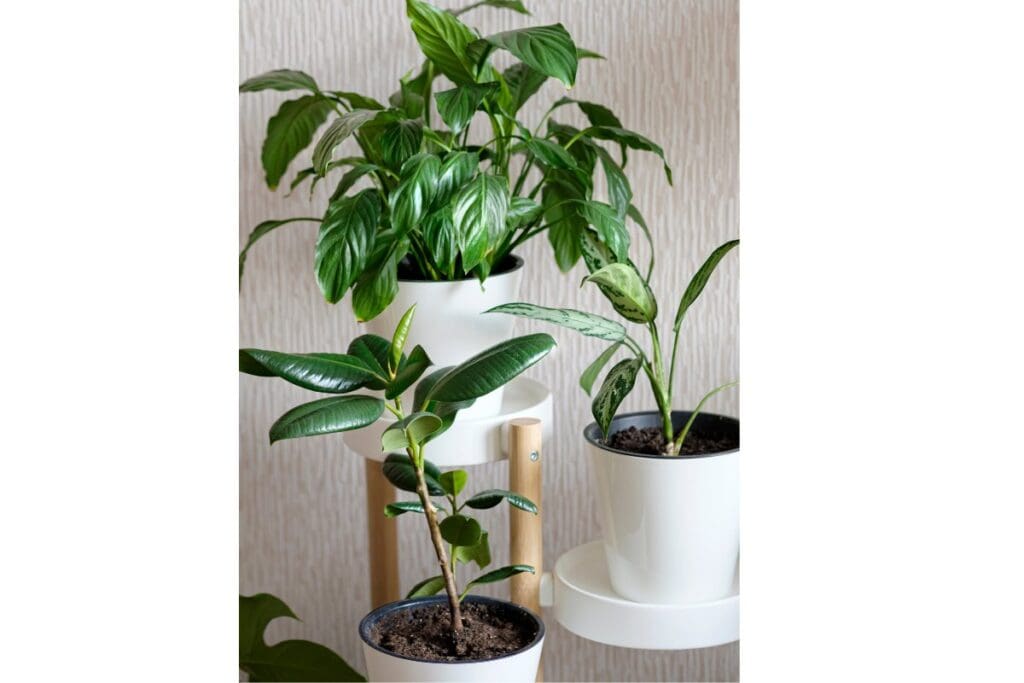
If you have multiple tropical plants that love high humidity levels, you can keep them together in one place.
As the plants transpire and lose moisture, it adds humidity to the surrounding air and increases it.
However, be a bit careful while approaching this method.
First, ensure that all the plants you plan to keep together are pest-free.
If one is infected, all the others get infected.
It is something you wouldn’t want.
Secondly, make sure that all the plants receive proper air circulation.
Staying too close to each other can increase too much humidity, and lack of airflow can invite pests and diseases.
Thirdly, do not let the leaves touch each other.
Keep an eye on your plants regularly as long as you plan to group them.
Reduce the room temperature.
Lowering room temperature is effective in high-temperature regions for increasing humidity levels.
Lowering the temperature of the room without the change in the water vapor amount will increase the humidity level in the air on its own.
Water starts condensing and forms dew.
However, don’t place your plant close to any cooling or heating systems to lower the temperature.
Try this method only if your region is always high in temperatures; otherwise, it can reverse.
If you try to reduce the temperature that is already low, the plant might suffer from cold drafts.
Reducing the room temperature gradually encourages easy adaptation without sudden exposure of the plant to extreme temperature changes.
Final thoughts
Mist Rubber plants during dry weather to increase humidity and maintain moisture levels. The Rubber plants are strong and low-maintenance. Humidity is a crucial requirement for their well-being. Therefore, they benefit from misting when the temperature is very low or dry.
Additionally, misting can keep pests and infections at bay if you mix some neem oil with water. Apply it every two weeks. Misting can also keep the leaves clean and tidy. It further increases their shine and health.
There are more effective ways to adjust humidity besides misting, like installing humidifiers, using pebble trays, keeping the plant close to water tanks or aquariums, grouping the plants, and lowering the room temperature.
What is the water requirement for the Rubber plants?
Rubber plants need a consistently moist growing medium. So, you can water the plants whenever the top few inches have dried. In the winter, the dormant plant can benefit from occasional misting.
How much humidity levels should I increase for the Rubber plants?
Rubber plants love humidity, but not too high. Excessive high humidity can invite pests and diseases like powdery mildew. 50-60% is enough.
Reference: Ficus Elastica Wikipedia
Recommended Garden Supplies
| Product Image | Our Recommended Gardening Supplies | Check Offers! |
|---|---|---|
Top Top
Top
Top
Top
Top
Top
Top
Top | rePotme Houseplant and Tropical Classic Potting Soil Mix | Check Offer On Amazon |
 Top
Top
Top
Top
Top
Top
Top
Top | Espoma Organic Indoor Plant Food | Check Offer On Amazon |
 Top
Top
Top
Top
Top
Top
Top
Top | GooingTop LED Grow Light 6000K Full Spectrum Clip Plant Growing Lamp | Check Offer On Amazon |
 Top
Top
Top
Top
Top
Top
Top
Top | Soil Moisture Meter | Check Offer On Amazon |
 Top
Top
Top
Top
Top
Top
Top
Top | Govee Hygrometer Thermometer, Bluetooth Enabled! | Check Offer On Amazon |
 Top
Top | LEVOIT Humidifiers for Large Room(Best For Plants) | Check Offer On Amazon |
 Top
Top
Top
Top
Top
Top
Top
Top | Upgraded DIY Automatic Drip Irrigation Kit, 15 Potted Houseplants Support | Check Offer On Amazon |
 Top
Top
Top
Top
Top
Top
Top
Top | Stainless Steel Heavy Duty Gardening Tool Set | Check Offer On Amazon |
 Top
Top
Top
Top
Top
Top
Top
Top | Bonide Insecticidal Soap | Check Offer On Amazon |
 Top
Top
Top
Top
Top
Top
Top
Top | Bonide 32 oz Spray Neem Oil for Organic Gardening | Check Offer On Amazon |
 Top
Top
Top
Top
Top
Top
Top
Top | Garden Safe Fungicide | Check Offer On Amazon |


